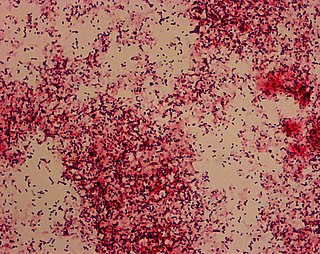
Psittacosis—also known as parrot fever, and ornithosis—is a zoonotic infectious disease in humans caused by a bacterium called Chlamydia psittaci and contracted from infected parrots, such as macaws, cockatiels, and budgerigars, and from pigeons, sparrows, ducks, hens, gulls and many other species of birds. The incidence of infection in canaries and finches is believed to be lower than in psittacine birds.
Streptococcus suis is a peanut-shaped, Gram-positive bacterium, and an important pathogen of pigs. Endemic in nearly all countries with an extensive pig industry, S. suis is also a zoonotic disease, capable of transmission to humans from pigs.
Aujeszky's disease, usually called pseudorabies in the United States, is a viral disease in swine that has been endemic in most parts of the world. It is caused by Suid herpesvirus 1 (SuHV-1). Aujeszky's disease is considered to be the most economically important viral disease of swine in areas where classical swine fever has been eradicated. Other mammals, such as cattle, sheep, goats, cats, dogs, and raccoons, are also susceptible. The disease is usually fatal in these animal species.

Cefquinome is a fourth-generation cephalosporin with pharmacological and antibacterial properties valuable in the treatment of coliform mastitis and other infections. It is only used in veterinary applications.
Actinobacillosis is a zoonotic disease caused by Actinobacillus.
Bovine Adenovirus, also known as BAdV, is a member of the Adenoviridae family that causes disease in cattle. There are 10 serotypes recognised and the virus had a worldwide distribution—being particularly common in Africa and Central America.
Bovine gammaherpesvirus 4 (BoHV-4) is a member of the Herpesviridae family. It is part of the subfamily Gammaherpesvirinae and genus Rhadinovirus. Infection is normally sub-clinical but can cause reproductive disease in cattle such as endometritis, vulvovaginitis and mastitis. Transmission is both vertical and horizontal. It can also be indirectly spread by fomites. Distribution is worldwide and the virus infects a range of ruminants, including bison, buffalo, sheep and goats.
Contagious caprine pleuropneumonia (CCPP) is a cause of major economic losses to goat producers in Africa, Asia and the Middle East.
Edwardsiella ictaluri is a member of the family Hafniaceae. The bacterium is a short, gram negative, pleomorphic rod with flagella. It causes the disease enteric septicaemia of catfish (ESC), which infects a variety of fish species. The bacteria can cause either acute septicaemia or chronic encephalitis in infected fish. Outbreaks normally occur in spring and autumn.

Cardiovirus A is a member of the Picornaviridae family. Infection with the virus causes encephalomyocarditis and reproductive disease in pigs. Although a variety of mammals may host the virus, pigs are classed as the domestic host as they are most easily infected. It is thought to be spread by rodents.
Inclusion body rhinitis (IBR), or cytomegalic inclusion disease, is a pig disease caused by Suid betaherpesvirus 2 (SuHV-2), which is a member of the herpesvirus family. It is a notifiable disease that is found worldwide. It is spread both vertically and horizontally and prevalence is high.
Mycoplasma hyorhinis is a species of bacteria in the Mycoplasmataceae family. It is often found as a commensal in the respiratory tract of pigs, and rarely in the skin of humans. M. hyorhinis is thought to facilitate and exacerbate the development of diseases such as porcine enzootic pneumonia and porcine reproductive and respiratory syndrome (PRRS). Rarely, it may cause mycoplasma arthritis, mycoplasmal polyserositis or mycoplasma septicaemia in piglets without the involvement of other bacteria. This presents as polyarthritis or polyserositis.
Mycoplasma synoviae is a species of bacterium in the genus Nycoplasma. It causes disease in the joints, bones and respiratory system of birds. It is found throughout the world and infection may be referred to as Infectious Synovitis, Avian Mycoplasmosis, Infectious Sinusitis and Mycoplasma Arthritis. It is of economic importance because infection can cause a drop in egg production. The disease is most commonly seen in chickens, and transmission occurs both vertically and horizontally.
Porcine adenovirus is a virus in the family Adenoviridae. It causes mild gastrointestinal diseases in pigs and is thought to contribute to multifactorial porcine respiratory diseases complexes. Several strains of the virus can be found worldwide, and transmission occurs horizontally by the fecal-oral route.
Porcine intestinal spirochaetosis is a notifiable pig disease caused by certain spirochetal bacteria (Brachyspira hyodysenteriae and Brachyspira pilosicoli. Infection causes mild gastrointestinal signs in young pigs and can also be transmitted as intestinal spirochetosis in humans, as it is a zoonosis.

Renibacterium salmoninarum is a member of the Micrococcaceae family. It is a Gram-positive, intracellular bacterium that causes disease in young salmonid fish. The infection is most commonly known as "bacterial kidney disease" but may also be referred to as BKD, White Boil Disease, Dee Disease, Salmonid Kidney Disease and Corynebacterial Kidney Disease. It is of significant ecologic importance due to its effect on both farmed and wild salmonids. The disease is found in North America, Europe, Japan, Chile and Scandinavia, and is spread both vertically and horizontally. Pacific salmon appear to be the most susceptible to the disease.
Riemerella anatipestifer is a member of the Flavobacteriaceae family. It is a Gram-negative bacterium that causes septicaemia and death in young ducks and geese throughout the world. There are 21 known serotypes and infection is spread horizontally between birds. Infection may be referred to as Duck Septicaemia, Goose 'flu, Riemerellosis, New Duck Disease and Polyserositis.
Blue eye disease is caused by La Piedad Michoacán Mexico virus (LPMV), the only member virus of the species Porcine orthorubulavirus in the Paramyxoviridae family. Synonyms for the disease include "Blue Eye Syndrome" and "Porcine Paramyxovirus Blue Eye Disease", and "La Piedad Michoacán Paramyxovirus Infection".
Actinobacillus pleuropneumoniae, is a Gram-negative, facultative anaerobic, respiratory pathogen found in pigs. It was first reported in 1957, and was formally declared to be the causative agent of porcine pleuropneumonia in 1964. It was reclassified in 1983 after DNA studies showed it was more closely related to A. lignieresii.
Actinobacillus equuli is a gram-negative, non-motile rod bacteria from the family Pasteurellaceae.




